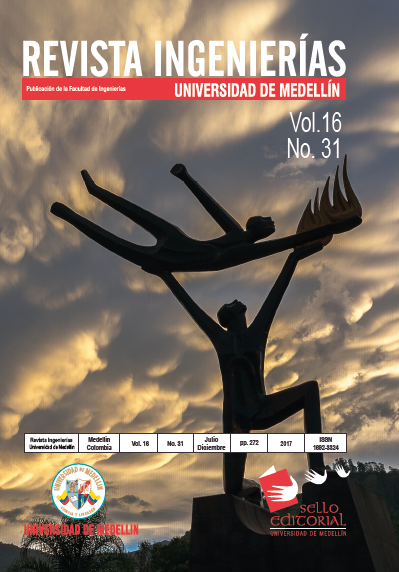Model of dynamic orchestration for SaaS
DOI:
https://doi.org/10.22395/rium.v16n31a7Keywords:
atomic services, cloud computing, dynamic orchestration, microservices, software as a service, workflowAbstract
Cloud Computing is an ubiquitous model that enables clients to access different services in a fast and easy manner. In this context, one of the most used models is Software as a Service (SaaS), which means that software is deployed and provisioned to the customer via internet through a web browser on a pay per use mode. However, given its complexity and characteristics, such as reusability, scalability, flexibility and customization, SaaS may be defined by workflows, which consist of atomic services, or micro-services hosted geographically in different places. SaaS execution under this type of composition may lead to abnormal behavior or failures in the end user applications at runtime. This paper presents a new model of dynamic orchestration for SaaS, which aims to reduce failures or abnormal behavior of the services involved in the execution process of business application.Downloads
Download data is not yet available.
References
[1] IBM Center, “Champions of Software as a Service: How SaaS is fueling powerful competitive advantage,†Armonk, NY, pp. 1-11, 2014.
[2] M. Mistretta, “El estado actual del cloud computing en México,†InformationWeek, septiembre, n.° 230. pp. 16-20, 2013.
[3] Cisco, “Cisco Global Cloud Index : Forecast and Methodology, 2014–2019,†White Pap., pp. 1–41, 2014
[4] K. Bousselmi, Z. Brahmi, and M. M. Gammoudi, “Cloud Services Orchestration: A Comparative Study of Existing Approaches,†in 2014 28th International Conference on Advanced Information Networking and Applications Workshops, pp. 410–416, 2014.
[5] J. Lewis and M. Fowler, “Microservices,†martinfowler.com, 2014. Available: http://martinfowler.com/articles/microservices.html, March 25, 2014.
[6] J. Wang, P. Korambath, I. Altintas, J. Davis, and D. Crawl, “Workflow as a Service in the Cloud: Architecture and Scheduling Algorithms,†Procedia Computer Science, vol. 29, pp. 546–556, 2014.
[7] K. Klai and H. Ochi, “Model Checking of Composite Cloud Services,†in 2016 IEEE International Conference on Web Services (ICWS), pp. 356–363, 2016.
[8] J. M. Myerson, “The role of Software as a Service in cloud computing SaaS maturity,†no. April, pp. 1–8, 2009.
[9] European Commission, “Cloud Service Level Agreement Standardization Guidelines,†Digital Agenda for Europe. [Online]. Available: ec.europa.eu//digital-agenda/en/news/cloud-servicelevel-agreement-standardisation-guidelines, June 2014.
[10] J. Terpak, P. Horovcak, and M. Lukac, “Mathematical models creation using orchestration and choreography of web services,†2016 17th Int. Carpathian Control Conf., pp. 739–742, 2016.
[2] M. Mistretta, “El estado actual del cloud computing en México,†InformationWeek, septiembre, n.° 230. pp. 16-20, 2013.
[3] Cisco, “Cisco Global Cloud Index : Forecast and Methodology, 2014–2019,†White Pap., pp. 1–41, 2014
[4] K. Bousselmi, Z. Brahmi, and M. M. Gammoudi, “Cloud Services Orchestration: A Comparative Study of Existing Approaches,†in 2014 28th International Conference on Advanced Information Networking and Applications Workshops, pp. 410–416, 2014.
[5] J. Lewis and M. Fowler, “Microservices,†martinfowler.com, 2014. Available: http://martinfowler.com/articles/microservices.html, March 25, 2014.
[6] J. Wang, P. Korambath, I. Altintas, J. Davis, and D. Crawl, “Workflow as a Service in the Cloud: Architecture and Scheduling Algorithms,†Procedia Computer Science, vol. 29, pp. 546–556, 2014.
[7] K. Klai and H. Ochi, “Model Checking of Composite Cloud Services,†in 2016 IEEE International Conference on Web Services (ICWS), pp. 356–363, 2016.
[8] J. M. Myerson, “The role of Software as a Service in cloud computing SaaS maturity,†no. April, pp. 1–8, 2009.
[9] European Commission, “Cloud Service Level Agreement Standardization Guidelines,†Digital Agenda for Europe. [Online]. Available: ec.europa.eu//digital-agenda/en/news/cloud-servicelevel-agreement-standardisation-guidelines, June 2014.
[10] J. Terpak, P. Horovcak, and M. Lukac, “Mathematical models creation using orchestration and choreography of web services,†2016 17th Int. Carpathian Control Conf., pp. 739–742, 2016.
Additional Files
Published
2018-02-26
How to Cite
Ruiz Paz, S. F., Santaolaya Salgado, R., & Fragoso DÃaz, O. G. (2018). Model of dynamic orchestration for SaaS. Revista IngenierÃas Universidad De MedellÃn, 16(31), 143–153. https://doi.org/10.22395/rium.v16n31a7
Issue
Section
Articles
License
The total or partial reproduction of the contents of the journal for educational, research, or academic purposes is authorized as long as the source is cited. For reproduction for other purposes, express authorization from the Sello Editorial Universidad de MedellÃn is required.

